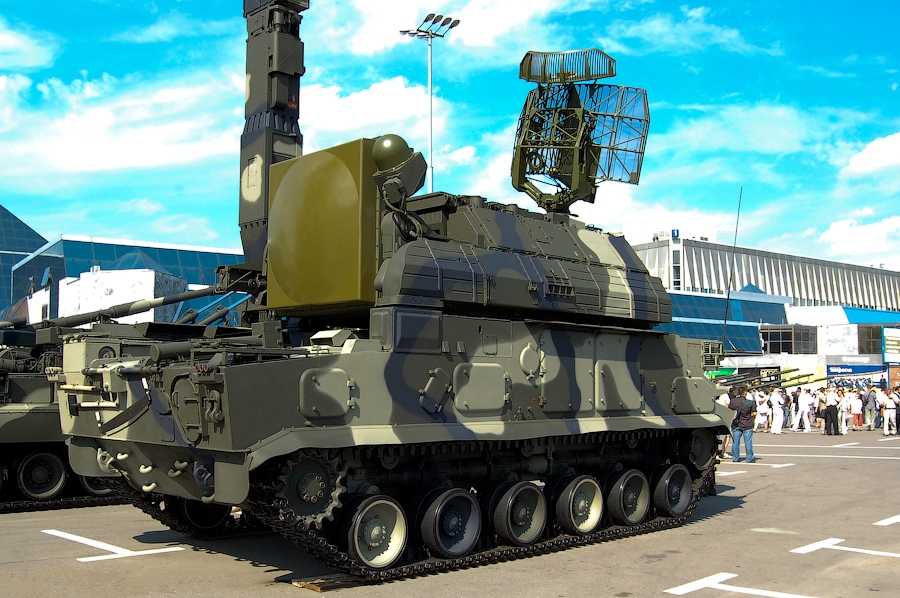Chinese military tested an updated surface-to-air defense missile in Xinjiang, apparently in a show of deterrence ahead of the India-US military drills in October that will take place 100 kilometers from the Line of Actual Control (LAC) – the de facto border between India and China.
US Wins 1st Round Of Electronic Warfare Bout Against China; Experts Admit PLA’s EW Equipment Was Crippled
US Anti-Tank Missiles Are ‘Struggling To Fire’ In Ukraine; Leaked Documents Reveal A Poor Hit-To-Miss Ratio
China’s state-owned broadcaster, CCTV, reported on August 16 that the People’s Liberation Army’s (PLA’s) Xinjiang Military Command conducted tests of an updated surface-to-air defense missile in the region’s high-altitude plateau at the height of more than 4,500 meters (14,760 feet).
As part of the tests, the missile struck a target plane flying at a low altitude in the first round of strikes.
This was followed by the system test in electronic warfare (EW) environment, in which the system operators performed evasive procedures and hit a target despite strong electronic interference from the aircraft.
According to Yue Gang, a former PLA colonel, the drills involved a new type of HQ-17A short-range air defense (SHORAD) missile.
‘Impossible To Intercept’: Meet Russia’s ‘Dagger’ Hypersonic Missile That Putin Is Using To Intimidate NATO
HellFire! A Small Grenade Blows Up Russian Tank Worth Millions Of Dollars; Video Takes Netizens By Storm
The HQ-17A Air Defense System
The HQ-17A is a variant of the basic HQ-17, which uses a wheeled chassis, whereas the basic version is based on a tracked chassis. It made its first public appearance in October 2019, during the National Day military parade in Beijing.
The HQ-17 air defense system is based on the Russian Tor-M1 surface-to-air missile defense system.
China is said to have reverse engineered the Tor-M1 to produce the HQ-17 after its request for domestic license manufacturing rights for the Russian system was reportedly denied by Moscow.
The HQ-17 incorporates an Identification Friend or Foe (IFF) array on top of an electronically scanned array radar, modernized electronics, a new all-terrain launcher, and the ability to data-link with other Chinese systems.
The HQ-17 missile appears physically identical to the Tor-M1, weighing roughly 165 kilograms, a length of nearly 2.9 meters, and a diameter of approximately 0.23 meters.

Compared to Tor-M1, the HQ-17 missile has a slightly longer slant range of 1.5-15 kilometers for intercepting flying aerial targets, and it operates at an altitude of 10 meters to 10 kilometers.
The export version of the system called the HQ-17AE was given a green signal in March 2021. Each HQ-17A/AE launch vehicle carries one passive electronically scanned array (PESA) search radar and an active electronically scanned array (AESA) guiding radar.
Also, in the tracked variant, the search radar is in the front and the guidance radar in the back, whereas in the wheeled version, the arrangement is reversed.
The HQ-17A system is intended to be a highly mobile air defense missile at the terminal stage and close range so that it can be deployed rapidly in forward areas to protect troops or vital installations from airborne threats such as helicopters, low-flying close air support aircraft, and Unmanned Aerial Vehicles (UAVs).
The state-owned China Aerospace Science and Industry Corporation (CASIC) describes the system as a ‘low altitude aircraft hunter’ because of its ability to intercept highly maneuverable aerial targets and resist saturation attacks.
PLA HQ-17A SAM launches missile in move.#PLA #China #HQ17 #SAM pic.twitter.com/FnzGNeYybG
— Húrin (@Hurin92) May 26, 2021
The vehicle can launch while mobile and intercept tactical air-to-ground missiles, anti-radiation air-to-ground missiles, and subsonic cruise missiles. Furthermore, China claims the system can intercept stealth aircraft and even supersonic cruise missiles and rockets.
The system manufacturer states that each HQ-17AE vehicle can carry eight missiles and guide four missiles to attack four targets simultaneously.
US-India Military Exercises
The timing of the live fire drills by Xinjiang Command is noteworthy, as it comes ahead of the bilateral military drills between the US and India, ‘Yudh Abhyas,’ slated to occur in October, involving two weeks of a high-altitude military exercise in Uttarakhand’s Auli.
The Xinjiang Command is a part of the PLA’s Western Theater Command that oversees the 3,488 kilometers long disputed border between China and India, also called the Line of Actual Control (LAC).
Therefore, according to Yue Gang, the latest live-fire drills suggest China’s concerns about the upcoming US-India exercises.
“Now the PLA is carrying out high-profile fire strike exercises on the plateau, with the aim of deterrence and countermeasures,” Gang said.
“[The US-India drill] will show off forces at the gate of China. But no matter one country or many countries, China is not afraid to prepare for war,” he added.
However, not all Chinese military experts agree with Gang’s assessment. For example, Song Zhongping, a former Chinese military instructor, said that the drills were routine exercises unrelated to the US-India exercise.
- Contact the author at tanmaykadam700@gmail.com
- Follow EurAsian Times on Google News